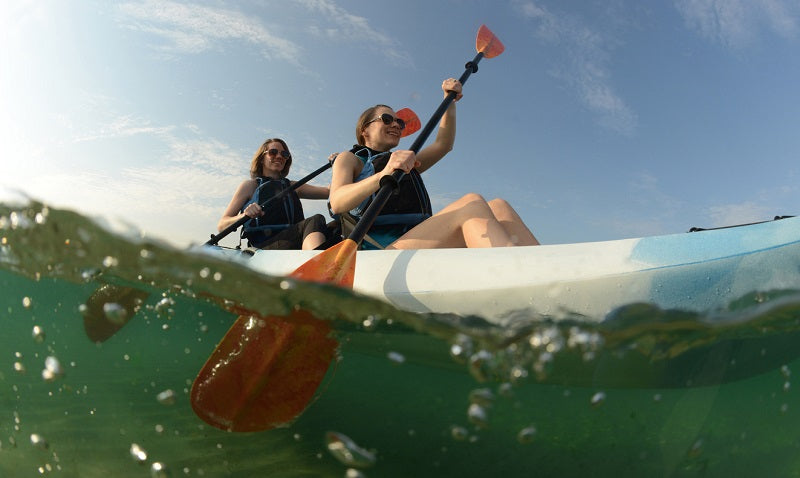Kayaking is one of the most popular explorative, outdoor water activities in the world today and it’s not hard to see why. With its close proximity to the water and the manoeuverability, portability and convenience of a kayak, kayaking can bring fun and excitement to both seasoned and newbie kayakers alike.
Like any outdoor water activity however, kayaking requires learning a few essential techniques. While kayaks may not come with complicated motors and controls, you’ll still need to learn a few basic moves to properly navigate your kayak in the water.
Getting on Your Kayak
The first move you’ve got to learn when kayaking is how to get on your kayak. This can be tricky, as the kayak will wobble, but should be easy once you get the hang of it. You’ll need to launch your kayak into shallow water first so that it’s close to shore but fully afloat. Take care not to drag the hull when you do this, as it could be damaging. Instead, have a friend help you carry the kayak and set it down in shallow water.
Next, place the shaft of your kayak paddle across the front of the cockpit perpendicular to the kayak. This will act like an outrigger and help to keep the kayak stable. Holding the cockpit rim and the paddle shaft at the same time, step into the cockpit and sit on the rear deck, before extending your legs forward into the cockpit. Then slide your body forward until your bottom is comfortably seated on the kayak seat. Your bent knees should be pressed firmly against the insides of the deck and your feet positioned on the foot pegs.
When you need to exit the kayak later, simply follow the same steps but in reverse.
How to Kayak: Basic Strokes
Once on your kayak, you’ll need to learn a few basic strokes to get moving.
- Forward Stroke
The forward stroke is the most basic stroke of all. You start by holding your paddle with both hands about a shoulder-width apart, and positioning it horizontally above the cockpit rim. Then wind your torso to one side and extend the arm on the opposite side to completely immerse one of the paddle blades into the water next to your feet. Once fully immersed, pull the blade towards the back of the kayak while pushing the other side of the paddle, and rotating your body to the other direction. Once the stroke is complete, lift the blade out of the water and repeat with the opposite side.
- Reverse Stroke
This is the basic stroke for braking and also for moving backwards when you’ve already stopped. You start in the same position as the forward stroke with the paddle in both hands perpendicular to the kayak. Then turning to one side, extend your arm to the back of that same side, submerging the paddle blade into the water behind you. Once fully immersed, push the blade forward along the side of the kayak while turning your torso, and once the blade nears your foot lift it up and turn your torso to the other side and repeat.
- Sweep Stroke
The sweep stroke is the basic turning stroke, and can be done forwards or backwards. With the paddle in both hands, lean towards the side of the kayak that is opposite of where you intend to turn. Then extend your arm to dip the paddle blade as far as you can in the direction where you’d like to go. Once the blade is shallowly immersed, move it in a sweeping motion away from the direction where you’d like to turn, rotating your torso in the process.
- Sculling
Sculling allows you to move your kayak sideways while remaining centred. You do this by first raising your paddle to a vertical position on the side where you’d like to go, submerging the paddle blade on that side with the other blade directly above it. Then with the paddle blade at a slight angle, move the paddle back and forth in short movements just beside you, turning the angle of the blade to the opposite side each time you move it in the opposite direction. It’s important that the back and forth movements be swift and the paddle blade be only at a slight angle underwater, otherwise your kayak will move forwards and backwards instead of sideways.
A Note for Beginners
These are just a few of the most basic strokes you’ll need to learn on your first foray into kayaking. These will probably be enough to get you skimming through calm waters, though anything more adventurous will require some kayak courses.
If it’s your first time to try kayaking, it’s best to start in a small, calm body of water away from powerboat traffic. Make sure that you go on a sunny, windless day and limit your paddling time to under two hours to keep fatigue and complications low, and achieve optimum fun and comfort.
Make sure to wear the proper attire and a PFD, and never paddle farther from shore than the distance you’re easily able to swim.
Last but certainly not least, make sure you choose the right type of kayak for you. If you’re still looking to buy a kayak, you’ll find many different kinds of kayaks for sale right here at Waves Overseas. Have a look at our great selection, and should you have any questions regarding the best kayak to choose, please don’t hesitate to contact our friendly staff.

